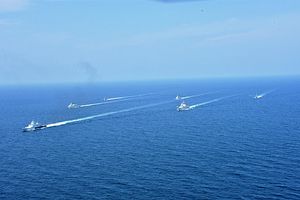Over the past week, Malaysia and Singapore held the latest iteration of their bilateral maritime exercise. The interaction cast light on the ongoing defense collaboration underway between the two Southeast Asian neighbors despite lingering challenges in the bilateral relationship.
As I have noted before in these pages, though Malaysia and Singapore have had a rather prickly relationship in the past and challenges do arise from time to time, their militaries still interact regularly through various bilateral exchanges and exercises as well as under multilateral arrangements, from the Five Power Defense Arrangements (FPDA) to Eyes-in-the-Sky combined patrols to enhance maritime security in the Straits of Malacca.
That has continued on into 2018 amid wider domestic and regional changes, be it the shock May election in Malaysia that returned Mahathir Mohamad back to the premiership or Singapore’s holding of the annually rotating ASEAN chairmanship this year. Indeed, just last month, both sides had conducted the 2018 iteration of Exercise Semangat Bersatu (XSB), drills between the two armies, in Malaysia and lasted from November 18 to November 28.
Over the past week, the defense aspect of the relationship has been in the headlines again with the holding of the bilateral maritime exercise Exercise Malapura. The iteration of the exercise, conducted since 1984, took place from November 26 to December 3.
As is usually the case, Exercise Malapura included phases such as the opening ceremony and joint planning and training, a sea phase, and an exercise debrief and closing ceremony. The sea phase included various operations including conventional naval warfare and maritime security drills in the Malacca Strait involving the Republic of Singapore Navy (RSN) and the Royal Malaysian Navy (RMN).
According to Singapore’s defense ministry (MINDEF), this year’s exercise, hosted by the RSN, involved about 600 personnel from both navies, which has tended to be roughly the number in recent iterations as well. In terms of assets, the RSN participated with a Formidable-class frigate RSS Tenacious with a S-70B Seahawk naval helicopter, a Victory-class missile corvette RSS Vigilance, a Fearless-class patrol vessel RSS Freedom, while the RMN participated with two Lekiu-class frigates KD Lekiu and KD Jebat, a Kasturi-class corvette KD Kasturi, a Super Lynx helicopter, as well as the two Royal Malaysia Air Force F/A-18D fighter aircraft to support an air defense exercise.
As is typical of such exercises, not much in the way of specifics was revealed about the exact shape of future iterations of the drills. And, to be sure, this is just one of many interactions between the two sides. Nonetheless, as both countries continue to recalibrate their ties amid bilateral and wider regional and global changes, such activities are worth paying attention to within that broader context.
































